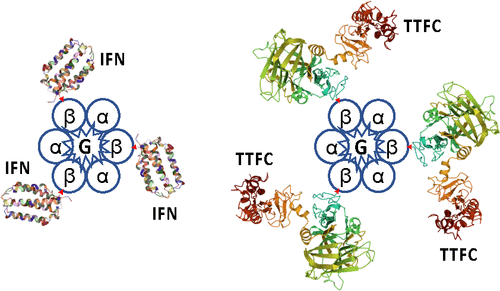当前位置:
X-MOL 学术
›
ACS Synth. Biol.
›
论文详情
Our official English website, www.x-mol.net, welcomes your
feedback! (Note: you will need to create a separate account there.)
Phycocyanin Fusion Constructs for Heterologous Protein Expression Accumulate as Functional Heterohexameric Complexes in Cyanobacteria
ACS Synthetic Biology ( IF 3.7 ) Pub Date : 2022-03-08 , DOI: 10.1021/acssynbio.1c00449 Diego Hidalgo Martinez 1 , Nico Betterle 1 , Anastasios Melis 1
ACS Synthetic Biology ( IF 3.7 ) Pub Date : 2022-03-08 , DOI: 10.1021/acssynbio.1c00449 Diego Hidalgo Martinez 1 , Nico Betterle 1 , Anastasios Melis 1
Affiliation

|
Overexpression of heterologous proteins from plants, bacteria, and human as fusion constructs in cyanobacteria has been documented in the literature. Typically, the heterologous protein “P” of interest is expressed as a fusion with the abundant CpcB β-subunit of phycocyanin (PC), which was placed in the leader sequence position. The working hypothesis for such overexpressions is that CpcB*P fusion proteins somehow accumulate in a soluble and stable form in the cytosol of the cyanobacteria, retaining the activity of the trailing heterologous “P” protein of interest. The present work revealed a substantially different and previously unobvious picture, comprising the following properties of the above-mentioned CpcB*P fusion constructs: (i) the CpcB*P proteins assemble as functional (α,β*P)3CpcG heterohexameric discs, where α is the CpcA α-subunit of PC, β*P is the CpcB*P fusion protein, the asterisk denotes fusion, and CpcG is the 28.9 kDa PC disc linker polypeptide CpcG1. (ii) The (α,β*P)3CpcG1 complexes covalently bind one open tetrapyrrole bilin co-factor per α-subunit and two bilins per β-subunit. (iii) The (α,β*P)3CpcG1 heterohexameric discs are functionally attached to the Synechocystis allophycocyanin (AP) core cylinders and efficiently transfer excitation energy from the assembled (α,β*P)3CpcG1 heterohexamer to the PSII reaction center, enhancing the rate of photochemical charge separation and electron transfer activity in this photosystem. (iv) In addition to the human interferon α-2 and tetanus toxin fragment C tested in this work, we have shown that enzymes such as the plant-origin isoprene synthase, β-phellandrene synthase, geranyl diphosphate synthase, and geranyl linalool synthase are also overexpressed, while retaining their catalytic activity in the respective fusion construct configuration. (v) Folding models for the (α,β*P)3CpcG1 heterohexameric discs showed the recombinant proteins P to be radially oriented with respect to the (α,β)3 compact disc. Elucidation of the fusion construct configuration and function will pave the way for the rational design of fusion constructs harboring and overexpressing multiple proteins of scientific and commercial interest.
中文翻译:

用于异源蛋白表达的藻蓝蛋白融合构建体作为功能性异六聚体复合物在蓝藻中积累
文献中已经记录了来自植物、细菌和人类的异源蛋白质作为蓝藻中的融合构建体的过度表达。通常,感兴趣的异源蛋白“P”表达为与藻蓝蛋白 (PC) 丰富的 CpcB β-亚基的融合体,该亚基位于前导序列位置。这种过表达的工作假设是 CpcB*P 融合蛋白以某种方式在蓝细菌的细胞质中以可溶和稳定的形式积累,保留了尾随异源“P”蛋白的活性。目前的工作揭示了一个截然不同且以前不明显的情况,包括上述 CpcB*P 融合构建体的以下特性:(i) CpcB*P 蛋白组装为功能性 (α,β*P) 3CpcG 异六聚体圆盘,其中 α 是 PC 的 CpcA α 亚基,β*P 是 CpcB*P 融合蛋白,星号表示融合,CpcG 是 28.9 kDa PC 圆盘接头多肽 CpcG1。(ii) (α,β*P) 3 CpcG1 复合物共价结合每个 α-亚基一个开放的四吡咯胆素辅因子和每个 β-亚基两个胆素。(iii) (α,β*P) 3 CpcG1 异六聚体圆盘在功能上连接到集胞藻别藻蓝蛋白 (AP) 核心圆柱体,并有效地从组装的 (α,β*P) 3转移激发能量CpcG1 异六聚体连接到 PSII 反应中心,提高了该光系统中的光化学电荷分离速率和电子转移活性。(iv) 除了在这项工作中测试的人类干扰素 α-2 和破伤风毒素片段 C,我们还表明植物来源的异戊二烯合酶、β-水芹烯合酶、香叶基二磷酸合酶和香叶基芳樟醇合酶等酶是也过表达,同时在各自的融合构建体构型中保持其催化活性。(v) (α,β*P) 3 CpcG1 异六聚体圆盘的折叠模型显示重组蛋白 P 相对于 (α,β) 3呈放射状取向压缩碟片。融合构建体配置和功能的阐明将为合理设计包含和过表达具有科学和商业价值的多种蛋白质的融合构建体铺平道路。
更新日期:2022-03-08
中文翻译:

用于异源蛋白表达的藻蓝蛋白融合构建体作为功能性异六聚体复合物在蓝藻中积累
文献中已经记录了来自植物、细菌和人类的异源蛋白质作为蓝藻中的融合构建体的过度表达。通常,感兴趣的异源蛋白“P”表达为与藻蓝蛋白 (PC) 丰富的 CpcB β-亚基的融合体,该亚基位于前导序列位置。这种过表达的工作假设是 CpcB*P 融合蛋白以某种方式在蓝细菌的细胞质中以可溶和稳定的形式积累,保留了尾随异源“P”蛋白的活性。目前的工作揭示了一个截然不同且以前不明显的情况,包括上述 CpcB*P 融合构建体的以下特性:(i) CpcB*P 蛋白组装为功能性 (α,β*P) 3CpcG 异六聚体圆盘,其中 α 是 PC 的 CpcA α 亚基,β*P 是 CpcB*P 融合蛋白,星号表示融合,CpcG 是 28.9 kDa PC 圆盘接头多肽 CpcG1。(ii) (α,β*P) 3 CpcG1 复合物共价结合每个 α-亚基一个开放的四吡咯胆素辅因子和每个 β-亚基两个胆素。(iii) (α,β*P) 3 CpcG1 异六聚体圆盘在功能上连接到集胞藻别藻蓝蛋白 (AP) 核心圆柱体,并有效地从组装的 (α,β*P) 3转移激发能量CpcG1 异六聚体连接到 PSII 反应中心,提高了该光系统中的光化学电荷分离速率和电子转移活性。(iv) 除了在这项工作中测试的人类干扰素 α-2 和破伤风毒素片段 C,我们还表明植物来源的异戊二烯合酶、β-水芹烯合酶、香叶基二磷酸合酶和香叶基芳樟醇合酶等酶是也过表达,同时在各自的融合构建体构型中保持其催化活性。(v) (α,β*P) 3 CpcG1 异六聚体圆盘的折叠模型显示重组蛋白 P 相对于 (α,β) 3呈放射状取向压缩碟片。融合构建体配置和功能的阐明将为合理设计包含和过表达具有科学和商业价值的多种蛋白质的融合构建体铺平道路。





















































 京公网安备 11010802027423号
京公网安备 11010802027423号